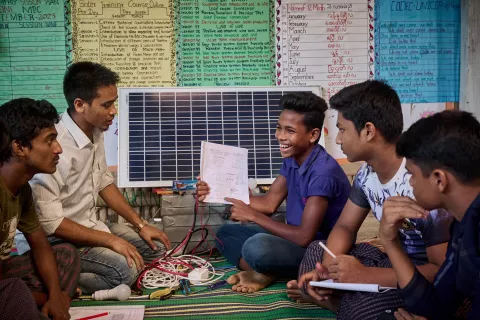Bridging the digital divide
How a leadership scout supported learning of primary school children in remote southern Bhutan.

Samtse: Almost every day, children of Tshachhu in Norgaygang, Samtse walk five hours to get to Changju Primary School - for electricity.
“My village does not have electricity. We do not have TV and there is no good mobile network,” says Nim Lhamo. The 20-year-old says that after the closure of schools due to the COVID-19 pandemic scare, children faced difficulty accessing online lessons. Although the village is powered by solar energy, it is not enough for the 50 households that make up the village.
While some children send their phones and devices with their parents, college students and others walk to the nearest places where electricity is available, which is often four to five hours walk away from the village.
“They go early, charge their devices, walk back in the evening and study the next day,” says Nim. “Teachers who are not used to walking in these conditions find it difficult to visit the village and when possible, the students sometimes visit the school to clarify their doubts.”
Seeing that many children in the community faced these difficulties, Nim, a leadership scout, began to help seven children with their lessons in her neighbourhood. “Even with Self Instructional Materials that were distributed, some children find it difficult to learn. I guide them with their lessons.”
One of the children she supported is a pre-primary student, Sangay Wangmo, 7. The lone child from the village to attend the primary school, Sangay lives with her father, grandmother, and great grandmother.
After she completed grade XII from Tendruk Central School in Samtse last year, Nim thought it was best to spend her time serving as a volunteer teacher at Changju Primary School. Many teachers are Desuups (civil volunteers) and working as front-liners. Given their shortage, she chose to volunteer as a teacher.
Nim was one of the leadership scouts who attended the orientation on COVID-19 prevention messages that the Scouts Division, Department of Youth and Sports with the Ministry of Education and UNICEF held in July.
Her interaction with the children helps Nim advocate with the community the COVID-19 prevention messages she learnt through the orientation training. She says that she shared with the neighbours and the parents COVID-19 prevention messages, the need to provide nutritious food to children and to recognize and understand the COVID-19 triggered problems related to health, education, protection and violence.
After the high schools reopened in September, Nim went back to studying. Today, she lives near Tendruk High School and attends classes as a supplementary candidate.
But she misses her time with the children and the elderly in the village. “Sangay’s great grandmother cannot walk and she asked me to visit her sometimes,” she says. “I am not with them now but I get great satisfaction that I was able to I help these children in my own small ways.”




